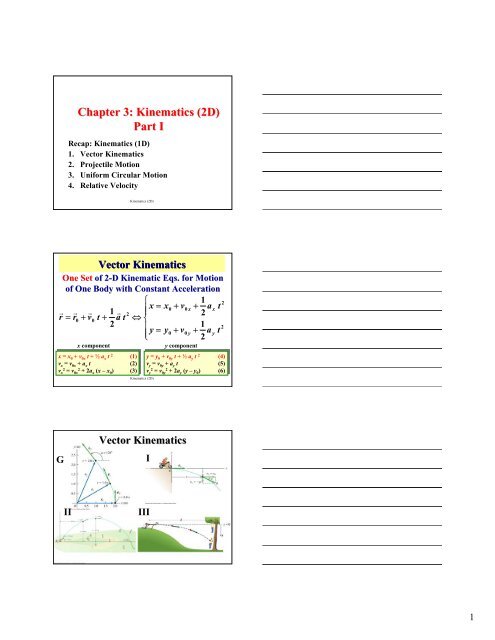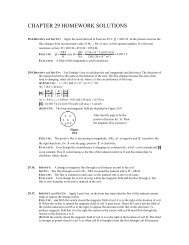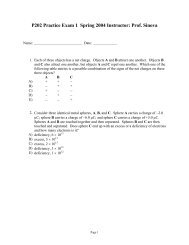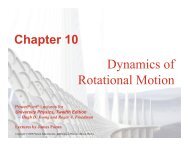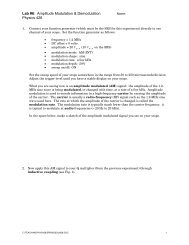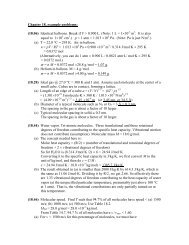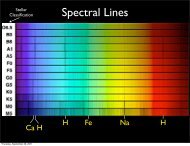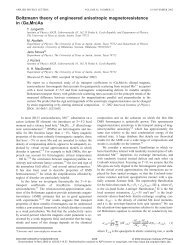Chapter 3: Kinematics (2D) Part I
Chapter 3: Kinematics (2D) Part I
Chapter 3: Kinematics (2D) Part I
You also want an ePaper? Increase the reach of your titles
YUMPU automatically turns print PDFs into web optimized ePapers that Google loves.
<strong>Chapter</strong> 3: <strong>Kinematics</strong> (<strong>2D</strong>)<strong>Part</strong> IRecap: <strong>Kinematics</strong> (1D)1. Vector <strong>Kinematics</strong>2. Projectile Motion3. Uniform Circular Motion4. Relative Velocity<strong>Kinematics</strong> (<strong>2D</strong>)Vector <strong>Kinematics</strong>One Set of 2-D 2 Kinematic Eqs. . for Motionof One Body with Constant Acceleration⎧1 2⎪x= x0+ v0x+ axtr r r 1 r 22=0+ v0t + a t ⇔ ⎨2 ⎪1 2y = y0+ v0y+ ayt⎩2x componenty componentx = x 0 0x t x t 2 (1)0 + v 0x t + ½ a x t 2 (1) y = y 0 0y t y t 2 (4)0 + v 0y t + ½ a y t 2 (4)v x 0x x t (2)x = v 0x + a x t (2) v y 0y y t (5)y = v 0y + a y t (5)v x2 0x2 2a x (x 0 ) (3)x2 = v 0x2 + 2a x (x – x 0 ) (3) v y2 0y2 2a y (y 0 ) (6)y2 = v 0y2 + 2a y (y – y 0 ) (6)<strong>Kinematics</strong> (<strong>2D</strong>)GVector <strong>Kinematics</strong>IIIIII<strong>Kinematics</strong> (<strong>2D</strong>)1
How to study Chap. 3 HWsKey ConceptsExamplesProblemsI1 body, with θ = 03.79*, 10*, 11, 67II1 body, with θ3.818*, 21, 47*, 52*,60, 61, 63, 64, 71III2 bodies with 2 a’s3.954*, 83*<strong>Kinematics</strong> (<strong>2D</strong>)* is HW problem.r r r 1 r 2 1 r3=0+ v0t + a t + b t2 6⎧12 2⎪x(t)= (2.0 m) + ( −0.5 m/s ) t2⇔ ⎨⎪13y(t)= (1.0 m/s) t + (0.15 m/s ) t⎩63Direction of Velocity <strong>Kinematics</strong> ≠ Direction (<strong>2D</strong>) of PositionONE <strong>2D</strong> Motion (Eqs.. 1 & 2)Study each motion between 0 s and 10 susing spreadsheet:• Calculate position every 0.5 s and plot them.• Calculate displacement• Calculate average velocity• Calculate velocity every 0.5 s• Calculate acceleration every 0.5 s<strong>Kinematics</strong> (<strong>2D</strong>)2
3<strong>Kinematics</strong> (<strong>2D</strong>)1.500-0.5008.500-5.0008.881-5.1254.441-2.56341.8835.00-23.0010.001.425-0.5007.769-4.7508.131-4.8754.066-2.43837.1530.93-20.569.501.350-0.5007.075-4.5007.419-4.6253.709-2.31332.7827.23-18.259.001.275-0.5006.419-4.2506.744-4.3753.372-2.18828.7623.85-16.068.501.200-0.5005.800-4.0006.106-4.1253.053-2.06325.0720.80-14.008.001.125-0.5005.219-3.7505.506-3.8752.753-1.93821.7118.05-12.067.501.050-0.5004.675-3.5004.944-3.6252.472-1.81318.6515.58-10.257.000.975-0.5004.169-3.2504.419-3.3752.209-1.68815.8713.37-8.566.500.900-0.5003.700-3.0003.931-3.1251.966-1.56313.3811.40-7.006.000.825-0.5003.269-2.7503.481-2.8751.741-1.43811.159.66-5.565.500.750-0.5002.875-2.5003.069-2.6251.534-1.3139.178.13-4.255.000.675-0.5002.519-2.2502.694-2.3751.347-1.1887.446.78-3.064.500.600-0.5002.200-2.0002.356-2.1251.178-1.0635.955.60-2.004.000.525-0.5001.919-1.7502.056-1.8751.028-0.9384.694.57-1.063.500.450-0.5001.675-1.5001.794-1.6250.897-0.8133.683.68-0.253.000.375-0.5001.469-1.2501.569-1.3750.784-0.6882.922.890.442.500.300-0.5001.300-1.0001.381-1.1250.691-0.5632.422.201.002.000.225-0.5001.169-0.7501.231-0.8750.616-0.4382.141.581.441.500.150-0.5001.075-0.5001.119-0.6250.559-0.3132.031.031.751.000.075-0.5001.019-0.2501.044-0.3750.522-0.1882.000.501.940.500.000-0.5001.0000.0001.006-0.1250.503-0.0632.000.002.000.00ayaxvyvxdy/dtdx/dtdydxdistancey (m)x (m)time (s)accelerationvelocityaveragevelocitydisplacementposition<strong>Kinematics</strong> (<strong>2D</strong>)Direction of velocity ≠ Direction of acceleration<strong>Kinematics</strong> (<strong>2D</strong>)Projectile MotionProjectile Motion2.00 m/sa = (0) i +(−g) j→→→Horizontal and vertical motionsanalyzed separately.
How fast must he motorcycle leave thecliff-top?HR?<strong>Kinematics</strong> (<strong>2D</strong>)This figure tells you a lot!<strong>Kinematics</strong> (<strong>2D</strong>)Further Look at Projectile Motion(3) v y = 0(1) Choose an origin &an x-y coordinate system(4) y = 0(2) a x = 0a y = −g = −9.80 m/s 2v x = constant<strong>Kinematics</strong> (<strong>2D</strong>)4
<strong>Kinematics</strong> (<strong>2D</strong>)<strong>Chapter</strong> 3: <strong>Kinematics</strong> (<strong>2D</strong>)<strong>Part</strong> II1. Vectors (and Scalars)2. Projectile Motion3. Uniform Circular Motion4. Relative Velocity<strong>Kinematics</strong> (<strong>2D</strong>)Example 1: A HunterA hunter aims directly at a target (on the samelevel) 65.0 m away. Note that the magnitude ofgravitational acceleration on the Earth is g = 9.80 m/s 2 .(a) (10 pts) If the bullet leaves the gun at a speedof 145 m/s, by how much will it miss thetarget?(b) (15 pts) At what angle should the gun be aimedso the target will be hit?<strong>Kinematics</strong> (<strong>2D</strong>)5
ISEEExample 1(a)Step 1: Draw a diagram (or picture) of thesituation, with coordinate axesISEEISEEStep 2: Think about which principle(s) ofphysics apply in this problem. (kinematic eqs.)Step 3: Write down kinematic equations.Step 4: Solve them.<strong>Kinematics</strong> (<strong>2D</strong>)Example 1: A HunterA hunter aims directly at a target (on the samelevel) 65.0 m away. Note that the magnitude ofgravitational acceleration on the Earth is g = 9.80 m/s 2 .(a) (10 pts) If the bullet leaves the gun at a speedof 145 m/s, by how much will it miss thetarget?(b) (15 pts) At what angle should the gun be aimedso the target will be hit?<strong>Kinematics</strong> (<strong>2D</strong>)ISEEExample 1(b)Step 1: Draw a diagram (or picture) of thesituation, with coordinate axesISEEISEEStep 2: Think about which principle(s) ofphysics apply in this problem. (kinematic eqs.)Step 3: Write down kinematic equations.Step 4: Solve them.<strong>Kinematics</strong> (<strong>2D</strong>)6
A boy on a small hill aims his water-balloon slingshot horizontally,straight at second boy hanging from a tree branch a distance daway. At the instant the water balloon is released, the second boylets go and falls from the tree, hoping to avoid being hit. Showthat he made the wrong move.<strong>Kinematics</strong> (<strong>2D</strong>)A boy on a small hill aims his water-balloon slingshot upward,directly at second boy hanging from a tree branch. At the instantthe water balloon is released, the second boy lets go and falls fromthe tree, hoping to avoid being hit. Show that he made the wrongmove.<strong>Kinematics</strong> (<strong>2D</strong>)200 m, given x??SameConceptH?d, given H?<strong>Kinematics</strong> (<strong>2D</strong>)7
Center-seeking Accelerationrˆ∆v∆l∆l= ∴∆v= vv rr∆v∆lv ∆lvv⎯⎯ t →∴ = = ⎯→v∆tr ⋅∆tr ∆tr∆ 0 a r<strong>Kinematics</strong> (<strong>2D</strong>)rradv= −r2ˆExample Problem 1The radius of the semicircular drive in front of theAdministration Building is 200 m. How fast could a sports carnegotiate the turn, assuming that it could achieve the magnitudeof a radial acceleration a rad = 0.8g? Ignore the stop sign at theintersection with East Gate Drive.<strong>Kinematics</strong> (<strong>2D</strong>)Example Problem 2People advocating space colonies say that it will be simple tosimulate gravity. One need only build a space module in theform of a doughnut (torus) and let it revolve at an appropriaterate. Consider a torus in circumference C = 10,000 m; it couldeasily accommodate 25 dwellings plus landscaping andgardens. How many times would the torus have to revolveeach hour in order that the magnitude of the radialacceleration at the rim equal g?<strong>Kinematics</strong> (<strong>2D</strong>)9
Problem: Relative Velocity in 1DA railroad flatcar is traveling to the right at aspeed of 13.0 m/s relative to an observer standingon the ground. A motor scooter is being riddenon the flatcar. Find the velocity (magnitude anddirection) of the scooter relative to the flatcar ifits velocity relative to the observer on the groundis:a) 20.0 m/s to the right;b) 4.00 m/s to the left;c) zero.<strong>Kinematics</strong> (<strong>2D</strong>)V P/BPersonV P/A =?V B/SV W/S =?θBank2.5 m/sRaftV B/A<strong>Kinematics</strong> (<strong>2D</strong>)ShoreBoatV B/W = 2.40 m/s10


